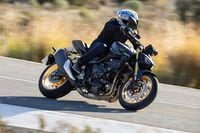"It's like going to a gunfight with a cannon."
That's how our inside source at BMW described the latest from Munich's motorcycle mavens, the HP2. Think of it as an R1200GS that got lost in the North African desert and had to mutate into a no-foolin' 105-horsepower dirtbike in order to survive.
The HP2 represents a whole new way of thinking for BMW. Rather than just building bikes with broad appeal, BMW has come up with HP-series motorcycles: High Performance, or HP in shorthand, with 2 designating both this particular motorcycle and BMW's evergreen boxer-twin engine. All HP bikes will be boxers; they'll be limited-production, carefully escorted through the design process by a small cadre of like-minded enthusiasts, and they'll be tightly focused on a specific segment of motorcycling. Some have said the HP models are equivalent to BMW's M-series cars, but the company has even grander visions for its HP hardware. For example, the HP2 is expected to tackle everything from tough off-road terrain to streaking WFO down the autobahn--not your normal everyday marching orders for most motorcycles.
Just as the M-series cars are based on production vehicles, the HP2 is based--however loosely--on an existing model, in this case the R1200GS. All that remains is the basic powerplant and the CAN bus electrical system. For life in the HP BMW recalibrated the engine management system for more horsepower (105 at 7000 rpm to the GS's 100) but identical torque (75 lb./ft. at 5500 rpm). One of the overriding design tenets for the HP2 was light weight, and to help accomplish that goal the flat-twin no longer has a balance shaft. Claimed dry weight is 386 pounds, an astonishing 53 pounds lighter than the standard 1200GS.
The chassis makes use of 25 years of enduro experience, with a steel-tube frame based on the firm's Dakar Rally bikes'. At the rear is BMW's usual Paralever system, for the HP2 a series of welded-up alloy shells, 1.2 inches longer than the GS's unit and finished in a magnesium-hued powder coating. Where the HP2 veers completely from conventional BMW thinking is in its suspension. At the rear, engineers have come up with a unique shock design that employs air both for spring and damping functions. And for the front suspension BMW has forsaken its Telelever design for a totally conventional 45mm upside-down telescopic fork. Actually, BMW had no choice. To get the same 10.6 inches of travel the Telelever pivot would have had to be located somewhere under the rider's saddle. Rolling stock consists of cross-spoke wheels and tires specially developed with Metzeler in a 21-inch-diameter front and a 17-inch-diameter rear.
And it's precisely this dirt-bike hardware that makes it possible to take the HP2's off-road aspirations seriously. According to our guy, "This bike isn't like the GS, where you have to be really careful how you ride it off-road. The HP2 actually handles the kind of stuff you'd encounter on a regular basis. And it's because they're using dirtbike components as opposed to something that was always designed to be on a street or touring bike."
As good as the basic platform is, it's the engine that's guaranteed to get--and hold--your attention. After all, we're talking about 105 horsepower here. "You rarely do more than just crack the throttle because it's just got so much power," our man says. "There really isn't a way to contain that power through a tire off-road. But there are times when you just want to do a big, honkin' slide, or just let 'er rip! It's sort of like a Kawasaki ZX-10 for the dirt."
Apart from such mind-bending performance at their fingertips, HP owners will also have privileges above and beyond the initial purchase. Exclusive training programs and special off-road tours specifically for HP2 buyers are just a couple of the perks BMW has in mind. It just goes to show you how far BMW has already planned to take the HP2 concept.
Still, the HP2's importance, both to motorcycling in general and BMW in particular, goes far beyond horsepower figures and banana republic-style organized tours. In the automotive world, BMW hasn't merely competed with other vehicles on equal ground, it has set new stand-ards of performance. Nothing has been further from the truth in BMW's motorcycle lineup, however, no matter how many claims the German maker has made for bikes such as the K1200S.
So, rather than compete directly against the leaders in established categories, with the HP2 BMW has done an end run by creating the first in a series of motorcycles that satisfies needs the market--and buyers--doesn't even know exist yet. One of the last motorcycle makers to try that was Honda. Remember what happened then?















/cloudfront-us-east-1.images.arcpublishing.com/octane/2WF3SCE3NFBQXLDNJM7KMXA45E.jpg)
/cloudfront-us-east-1.images.arcpublishing.com/octane/G4MG6OUCJNBSHIS2MVVOTPX65E.jpg)
/cloudfront-us-east-1.images.arcpublishing.com/octane/IIGGWFOTOJGB7DB6DGBXCCMTDY.jpg)
/cloudfront-us-east-1.images.arcpublishing.com/octane/QSTCM6AVEZA5JJBUXNIQ3DSOF4.jpg)
/cloudfront-us-east-1.images.arcpublishing.com/octane/U4I7G625B5DMLF2DVIJDFZVV6M.jpg)
/cloudfront-us-east-1.images.arcpublishing.com/octane/B6XD6LS6IVCQPIU6HXDJSM3FHY.jpg)
/cloudfront-us-east-1.images.arcpublishing.com/octane/ICL63FEDDRDTTMINYICCEYGMDA.jpg)
/cloudfront-us-east-1.images.arcpublishing.com/octane/FCGZHQXRBZFLBAPC5SDIQLVF4I.jpg)
/cloudfront-us-east-1.images.arcpublishing.com/octane/WNOB6LDOIFFHJKPSVIWDYUGOPM.jpg)

/cloudfront-us-east-1.images.arcpublishing.com/octane/X33NU3E525ECRHXLNUJN2FTRKI.jpg)
/cloudfront-us-east-1.images.arcpublishing.com/octane/6KKT5NNL2JAVBOXMZYS5ZO76YA.jpg)
/cloudfront-us-east-1.images.arcpublishing.com/octane/J5RKG5O455GMPGQRF2OG6LRT7A.jpg)
/cloudfront-us-east-1.images.arcpublishing.com/octane/GX2CIZKQVRH2TATDM26KFG2DAE.jpg)
/cloudfront-us-east-1.images.arcpublishing.com/octane/ZWIDYSAKQZHD5BHREMQILXJCGM.jpg)
/cloudfront-us-east-1.images.arcpublishing.com/octane/CYUHJZCTSJCH3MRAQEIKXK7SCQ.jpg)
/cloudfront-us-east-1.images.arcpublishing.com/octane/LKOFINY56FCXJCANJ5M7ZDQUBY.jpg)
/cloudfront-us-east-1.images.arcpublishing.com/octane/4NBPDACMWJH63JQYJVK3QRBDZI.jpg)
/cloudfront-us-east-1.images.arcpublishing.com/octane/KKHQHRR3FJGX7H2IPU6RALMWG4.jpg)

/cloudfront-us-east-1.images.arcpublishing.com/octane/5IOFS5JAE5FOXMNA23ZRAVVYUU.jpg)
/cloudfront-us-east-1.images.arcpublishing.com/octane/CGXQ3O2VVJF7PGTYR3QICTLDLM.jpg)

/cloudfront-us-east-1.images.arcpublishing.com/octane/OQVCJOABCFC5NBEF2KIGRCV3XA.jpg)